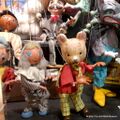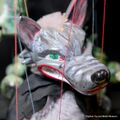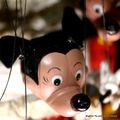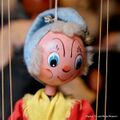Category:Pelham Puppets
| Toy Brands and Manufacturers |
|---|
Pelham Puppets |
| 1947 - |
Pelham's "Flying Pig" trademark [image info]
The Pelham Puppets range, originally produced by Bob Pelham’s company from 1947 to 1986, mostly consisted of string puppets (marionettes) but also included occasional rod, glove and ventriloquist dolls.
Pelham were based in Marlborough, Wiltshire where Bob Pelham had settled after the Second World War with the aim of producing children’s toys. For nearly 40 years Pelham produced thousands of puppets in many designs, shapes and styles which would go on to become some of Britain's most prized and collectable toys.

History
WW2 and "Wonky Toys"
Bob Pelham was called up to serve in the Armed Forces in 1939 at the outbreak of the Second World War. Throughout his time serving on active duty he became affectionately known as 'The Wonky Donkey Officer' due to his penchant for making small, wooden, animated donkey toys. This influenced him to start a toymaking company upon his return to Britain. After consulting Jan Bussell and Ann Hogarth (the operators of Muffin the Mule on the popular television programme) Bob set about designing puppets which would be simple enough for young children to operate and – Wonky Toys Ltd. – was born; a nod to his wartime nick-name. The early operations consisted of just a few workers based in a small work shop and nearly all of the materials used in the production of the puppets were recycled, either taken from Bob's father's house or salvaged from local scrap yards.
In the first months of the company Bob struggled to convince toy retailers that puppets would be a popular item to stock and he received many rejections, usually due to the perceived complicated nature of marionettes. Not to be deterred, Bob continued producing and designing his puppets and it was during this period that one of the company's most recognisable puppets was designed: Sandy MacBoozle. This puppet would be taken from store to store by Bob and used to show potential buyers that puppets were the next big thing in the toy market. MacBoozle would later go on to become one of the company's flagship puppets.
1947: Hamleys
Around the end of 1947 Bob struck gold when he approached Hamleys of Regent Street, London with his puppets and they agreed to let him demonstrate them from behind his own counter. They were an instant hit and Bob later recalled "By explaining how simple string puppets really were to work and showing a somewhat surprised audience their comical antics, the first puppets began to sell!".
After the launch of the puppets to a big name toy store, shops all over the country began placing orders and the following years proved to be extremely successful for the company.
1952: Expansion
These simple puppets, made from recycled materials and packaged in a simple brown box were so popular that by 1952, a mere five years later, the company was in need of much larger premises in order to keep up with the increased production. Pelham, whilst staying in Marlborough, moved its offices and retail store to Elcot Lane and one year later purchased a three-story factory on London Road, on the south bank of the River Kennet, which would go on the become the permanent home of Pelham until 1987, when the original company ceased trading.
1953: Licensed characters
The Pelham company went from strength to strength and at its peak was producing thousands of puppets in a multitude of different colours, sizes, designs and sets (see below). One of the biggest achievements for Bob came in 1953 when the company won the rights to produce a set of Disney puppets. This acquisition started a pattern of fighting for commercial rights to other brands and many sets followed including The Magic Roundabout, The Muppets, Peanuts and The Wombles.
1961: Fire
All of these successes however suffered a drastic set back when, in October 1961, the London Road factory caught fire and was nearly all destroyed. Stock, materials and documents were all lost but, not to be deterred, Bob and the rest of the company set about building a new factory on the same site, as quick as possible in order to catch up with the lost time.
1970s: Further expansion
The 70's proved to be the the busiest decade experienced by the company and rapid expansion was required in order to keep up with the now international demand which included shipping to over 40 countries. However, despite the fact that business had never been better, it was from this time that Bob began to lose his enthusiasm due to the ever increasing commercial nature of his company; it had grown from a small office of close colleagues to an enterprise based across several premises producing at full speed, all day every day.
1980s: Contraction
Bob's troubles reached their worst during the 1980's when Pelham had to make several hundred loyal employees redundant due to the falling economy. After this period of decline for the factory tragedy struck when, in mid 1980, Bob died suddenly at his home. His wife Anne, who had also been a long term employee of the company and had played a huge part in its success, continued to operate the company for the following six years until she reached the point of retirement and closed the original factory's doors for the final time.
Relaunch
Following the closure of the original Pelham factory and brand various companies tried, without much success, to bring back the former glory experienced in its heyday. The rights to the name traded hands many times until it was finally purchased by one-time employee, and long time friend of Bob's, David Leech. This venture, although not on the same scale as the original factory, produces Pelham Puppets to Bob's original designs and standards (as well as some new ones) and continues to be an ambassador for the brand.
Construction
SL Rupert the Bear [image info]
The construction methods and materials used for the puppets varied greatly throughout their history. New materials were hard to come by in the austerity of post-war Britain, and Bob initially had to obtain mainly recycled materials from a variety of unconventional sources. Repurposed army-surplus parts included wooden duffel-coat toggles used as feet, ammunition box partitions and even rubber respirator tubes used (suitably strung) as legs. Puppet fabrics were often hand-dyed parachute material, and were sometimes taken from old fabric sample books and jumble sales. Sometimes useful cloth could even be salvaged from scraps discarded by "normal" businesses.
As business grew and the ability to find materials around the country improved, so did the quality of the puppets. Hand-turned wooden heads, hands and arms were staples of production puppets up until the 1950s when, due to increased demand, a need for pre-made composite hands became apparent. Pre-constructed parts enabled a quick, assembly line process which greatly improved productivity. This means that one can often estimate the rough age of a puppet from the construction style and materials used on the hands and legs.
Licensed Characters
The increasing popularity of the company meant that more and more other companies were willing to allow their characters and brands to be turned into puppets by Pelham. This pattern started in 1953 with the acquisition of rights for Disney characters. Other companies that followed suit were The Muppets, Hanna Barbera, The Magic Roundabout and Peanuts.
Mickey Mouse [image info]
Rupert Bear [image info]
- Walt Disney
- Disney characters produced by Pelham were mostly available in SL models however there were some additional characters produced in other types. These include Mickey, Minnie and Pinocchio who were all produced as glove puppets as well and Mickey, Minnie and Pluto who were briefly available in the Minipup type.
- Pelham also produced some larger display models and a moving display unit was also produced for shops to demonstrate the range. The example on display includes Mickey, Minnie, Goofy, Donald Duck and Pluto.
- Magic Roundabout
- The Magic Roundabout was a television show created by Serge Danot which was first screened in Britain in the 1960s. It was an instant hit with many of the characters becoming extremely recognisable and Bob, equipped with his experience in Disney characters, soon acquired the rights to this show. Characters produced in this line include Florence, Dougal and Zebedee, and they came in a mixture of rod, glove and Jumpette types.
- The Muppets
- Jim Henson's popular tv show 'The Muppet Show' first screened in the UK in 1976 and lasted five years. During this time the show became well known and many famous celebrities of the time appeared on it. Pelham received the rights for The Muppets but only ever recreated two characters: Kermit and Animal.
- Hanna Barbera
- Hanna Barbera is the name of the animation studio responsible for many cartoon productions of the mid to late 20th Century. Many of these cartoons became hits not only in the USA but across the globe. Pelham collaborated with Hanna Barbera and created characters from The Flintstones, Huckleberry Hound, Pixie and Dixie and Mr Jinks and Yogi Bear.
- Peanuts
- Peanuts is the name of a cartoon strip created by Charles M. Schulz and later television programme and movie. the most recognisable characters from the Peanuts series are Snoopy the Dog and Charlie Brown. These two, along with Woodstock the bird were produced in a series by Pelham. The company also produced an animated unit with Peanuts characters much like the Disney one here in the museum.
- The Wombles
- The Wombles were a group of fictional creatures created by Elisabeth Beresford in 1967 and later made into a BBC television programme of the same name. The Wombles resembled badgers and spent their days collecting rubbish from Wimbledon Common and putting it to good use. From the mid 1970s to the early 1980s Pelham produced six of the Wombles which were available in the more modern plastic-fronted boxes.
Further reading
Cover of Pelham Puppets, by David Leech (2008) [image info]
- David Leech, Pelham Puppets: A collectors' guide (Crowood Collectors' Series) (Crowood Press, 2008) ISBN 9781847970558
- David Leech, Yours Puppetually Pelham Puppet I.D. and Collector's Guide (David Leech Productions, 1996)
External links
- Pelham Puppets homepage (pelhampuppets.uk.com)
- PELPOP by collectors for collectors (pelpop.com)
- Puppets Archive - Pelham Puppets (iandenny.co.uk)
- Pelham Puppets Ltd., V&A (collections.vam.ac.uk)
video:
- Interview with Bob Pelham and a tour of the Pelham Puppets factory, ITV, December 1959 (youtube.com) – video
- Very old mechanical Pelham Puppets display (youtube.com) – video
- British Pathé: Brighton Toy Fair 1968 (youtube.com) – at ~40 seconds in, animated "Beatles" Pelham Puppets display
Subcategories
This category has the following 6 subcategories, out of 6 total.
Pages in category ‘Pelham Puppets’
The following 48 pages are in this category, out of 48 total.
B
C
F
G
M
P
S
Media in category ‘Pelham Puppets’
The following 23 files are in this category, out of 23 total.
- Andy Pandy marionette (Pelham Puppets).jpg 1,200 × 1,198; 637 KB
- Area 54.jpg 1,024 × 1,023; 679 KB
- Big Bad Wolf Marionette (Pelham Puppets).jpg 1,200 × 1,200; 621 KB
- Dutch Girl marionette (Pelham Puppets).jpg 1,600 × 1,600; 388 KB
- Face, Pelham Puppets.jpg 2,500 × 1,667; 1.63 MB
- Flying Pig trademark, Pelham Puppets.jpg 959 × 1,600; 320 KB
- Gypsy Girl marionette (Pelham Puppets).jpg 1,198 × 1,200; 627 KB
- Have Fun with Pelham Puppets (MM 1953-05).jpg 2,200 × 1,646; 433 KB
- Mexican Gunfighter marionette (Pelham Puppets).jpg 1,200 × 1,200; 656 KB
- Mickey Mouse marionette (Pelham Puppets).jpg 800 × 798; 263 KB
- Mother Dragon marionette (Pelham Puppets).jpg 1,200 × 1,200; 662 KB
- Muffin the Mule marionette (Pelham Puppets).jpg 1,200 × 1,200; 535 KB
- Noddy marionette (Pelham Puppets).jpg 1,200 × 1,200; 583 KB
- Pelham Puppets logo mono.jpg 2,210 × 1,302; 163 KB
- Pelham Puppets makers plaque, Disney shop-window display.jpg 1,600 × 1,067; 705 KB
- Pelham Puppets Theatre, logo.jpg 1,600 × 1,067; 852 KB
- Pelham Puppets yellow retail box.jpg 3,000 × 1,245; 657 KB
- Pelham Puppets, by David Leech, front cover (ISBN 1847970559).jpg 940 × 1,200; 366 KB
- Pinocchio marionette (Pelham Puppets).jpg 1,200 × 1,199; 550 KB
- Red Riding Hood marionette (Pelham Puppets).jpg 1,200 × 1,200; 697 KB
- Rupert Bear marionette (Pelham Puppets).jpg 1,200 × 1,200; 570 KB
- Simple Dancing Puppet, brown box, Pelham Puppets.jpg 2,500 × 1,667; 1.88 MB
- Yellow box, Pelham Puppets.jpg 2,500 × 1,667; 2.08 MB































